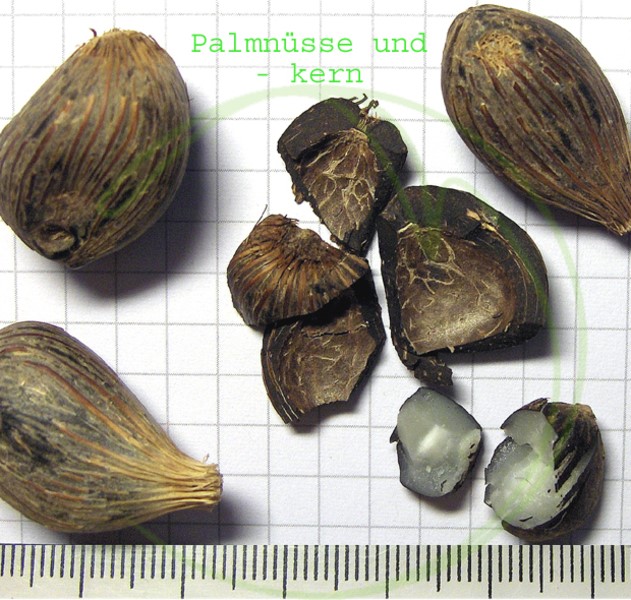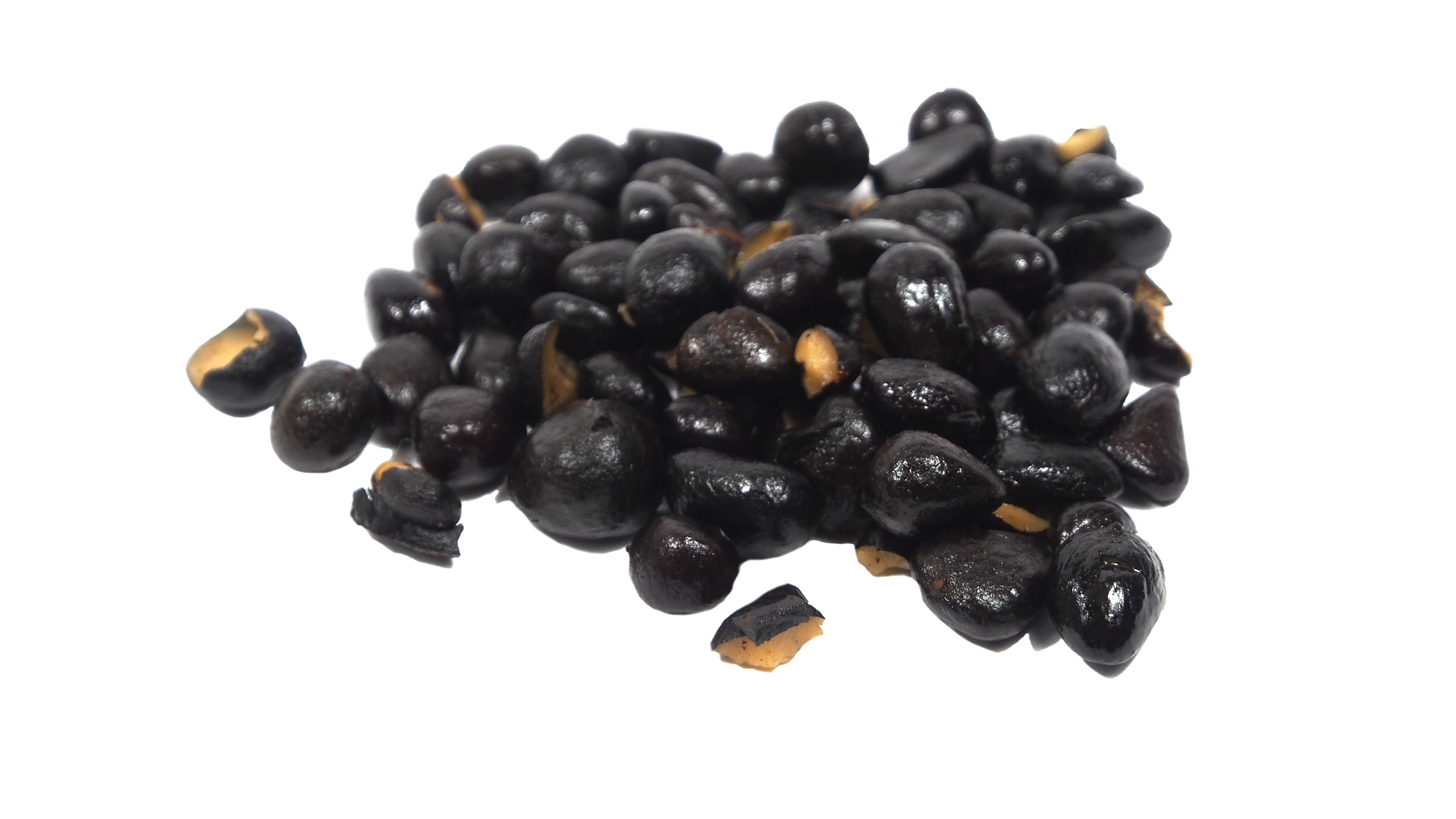
Palm kernel oil
Oil extraction
Palm oil (also palm fat) is produced from the flesh of the palm nuts, while palm kernel oil is produced from the kernels of the oil fruit. To obtain the palm oil, the fruits are pressed in mills so that the palm oil is obtained from the fleshy mesocarp. Because of their high carotene content, both the fruit and the oil obtained have an orange-red color. However, this can be removed by refining.
As a by-product of the oil pressing of the fruits, one also gets the palm nuts, which are undamaged despite the pressure during the pressing process of the palm fruits. However, they must first be freed from the fibers of the mesocarp and the shells and dried to a residual moisture content of about 8%. The latter serves to prevent mold growth.
The palm kernels thus prepared are then subjected to mechanical pressing. The result is high-quality press cake and palm kernel oil.
Characteristics and shelf life
Palm oil and palm kernel oil are distinct from one another in their character as well as in their fatty acid composition. Raw palm oil forms a buttery, dark to red-yellow fat. Refined oil, on the other hand, has a clear and light color. Through an aging process caused by micro-organisms (fermentation), the oil becomes cloudy and develops an intense scent.
Raw palm kernel oil is colored yellow to brownish; after being refined, it is an almost white to light yellowish fat.
The smell of palm oil is often described as faint, fresh, and slightly green. Palm kernel oil smells rather herbaceous, eucalyptus-like, spicy, a little fruity-sweet, as well as slightly green. Furthermore, it can also give off faint citrus notes.
Taste-wise, refined palm oil has a sweetish, pleasant taste. Palm oil’s melting point is between 30°C and 40°C. The flash point lies around 267°C. The melting of palm kernel oil, on the other hand, is lower and lies between 23°C and 30°C; the smoke point, around 220°C. Both palm oil and palm kernel oil are solid at room temperature.
Like the fruits, unrefined palm oil features a high carotene content, which is responsible for the orange-red color. Beyond this, unrefined palm oil also contains a high amount of Vitamin E, especially tocotrienols, and Vitamin A. The fatty acid composition of palm oil consists chiefly of saturated palmitic acid (ca. 44%) and monounsaturated oleic acid (ca. 39%). In addition are linoleic acid (around 11%), stearic acid (ca. 4%), and myristic acid )around 1%). Thus, the ratio of both saturated and monounsaturated fatty acids are nearly equal, each around 46%, while the polyunsaturated acids only comprise a relatively low percentage of 8%.
This fatty acid composition ratio is very different from that of palm kernel oil, for the latter contains up to around 83% saturated fatty acids, only ca. 15% monounsaturated fatty acids and around 2% polyunsaturated fatty acids. Oleic acid amounts to around 15% and linoleic acid only to around 2%. Besides lauric acid (48%), there are also palmitic acid (ca. 8%), myristic acid (ca. 16%), stearic acid (around 3%), capric acid (3%), and caprilic acid (ca. 3%).
Additionally, the oil contains many vitamins and minerals.
Palm oil should be stored in an aroma-tight container in order to prevent the palm oil from adopting other scents. It is also important to store it in a cool and dark location. The shelf life of unopened palm oil is several months.
Use
Currently, palm oil and palm kernel oil are chiefly used in the manufacture of foodstuff and in the kitchen. Only around 5% of it is processed into biofuel and the remainder of global palm oil production (ca. 10-22%) is used in industry, such as in the production of detergents and cosmetics.
Palm oil
Industrial use
Palm oil has a wide range of applications in this area, being used to produce soaps and candles and yield lauric acid. The latter in turn forms the basis for various surfactants. Additionally, palm oil is the raw material for several other products in the cosmetic and detergent industries. Palm oil can also be used in the production of biofuels (especially biodiesel and NEXBtL, a hydrogenated plant oil). This is occurring primarily in Indonesia, where it offers a number of advantages. For one thing, the palm fruits yield a large amount of oil (a larger oil yield per hectare when compared with rapeseed); for another thing, the use of palm oil diesel, when compared to conventional diesel, saves primary energy and therefore can reduce CO2 emissions. Beyond this, the use of palm oil diesel is supposed to be able to lower nitrogen oxide and particulate emissions; its production costs are low relative to other types of biodiesel; and this oil is also considered to be a renewable energy source, since the palms and their fruits continually grow anew. Despite its beneficial energy balance, palm oil also has one considerable disadvantage. The large-scale cultivation of oil palms, especially in Indonesia, requires the destruction of many square kilometers of tropical rain forests. Palm oil can also be used in cogeneration units.
In the kitchen
The main area of application for both palm kernel oil and palm oil is in the kitchen. On the one hand, palm oil is used in the food industry to produce margarine, sauces, baked goods and sweets, confectionaries, potato products and chocolate products; on the other hand, it is used mostly in Asia and Africa for frying, cooking, and deep-frying. Due to its excellent ability to withstand heat and oxidation, it is especially well-suited for the latter. It advantageously contains hardly any bound polyunsaturated fatty acids, which could transform into dubious trans-fatty acids through heat exposure. Additionally, because it contains a high percentage of Vitamin A and beta carotene, it is still considered healthy.
Palm kernel oil
Pharmaceutical and medical uses
Palm kernel oil is used as a basis for various creams.
Industrial use
Palm kernel oil has a wide range of applications in industry. For example, it is used in oleochemistry to obtain oleochemical intermediary products. It helps in obtaining lauric acid, which then serves as a basic material for various surfactants (for example, sodium lauryl sulfate and sorbitan monolaurate). Additional materials taken from palm kernel oil are also further processed in the cosmetic and detergent industries. Palm kernel oil can be found in the aluminum (aluminium) industry, where it is used to develop grease for rollers and deep-drawing processes for aluminum sheets. Finally, like palm oil, it also has many uses in the food industry. Its buttery flavor and relatively large percentage of short chain fatty acids make palm kernel oil a frequent choice in margarine production. Furthermore, due to its particular melting properties (being solid at room temperature, melting relatively quickly at body temperature, and leaving behind a cooling effect), it is especially well suited for the manufacture of cocoa glazes, ice cream coatings, ice chocolate, and cool-melting chocolate fillings. Palm kernel oil can also be found in caramel and toffees, where it helps preserve hardness and flavor. By undergoing various modification processes, this oil can also be processed into high-quality special fat.
We will be happy to advise you on this seed and show you options. Contact us
In addition to their own knowledge acquired through press trials, the following sources were used to create the article:
- Öle, natürlich kaltgepresst, Basiswissen & Rezepte, Marcus Hartmann, Hädecke, 2008
- Heilende Öle, Pflanzenöle als Nahrungs- und Heilmittel, Neue Erkenntnisse, Günter Albert Ulmer Verlag Tuningen
- Lexikon der pflanzlichen Fette und Öle, Krist, Buchbauer, Klausberger, SpringerWienNewYork, 2008
- www.wikipedia.de
- en.wikipedia.org

